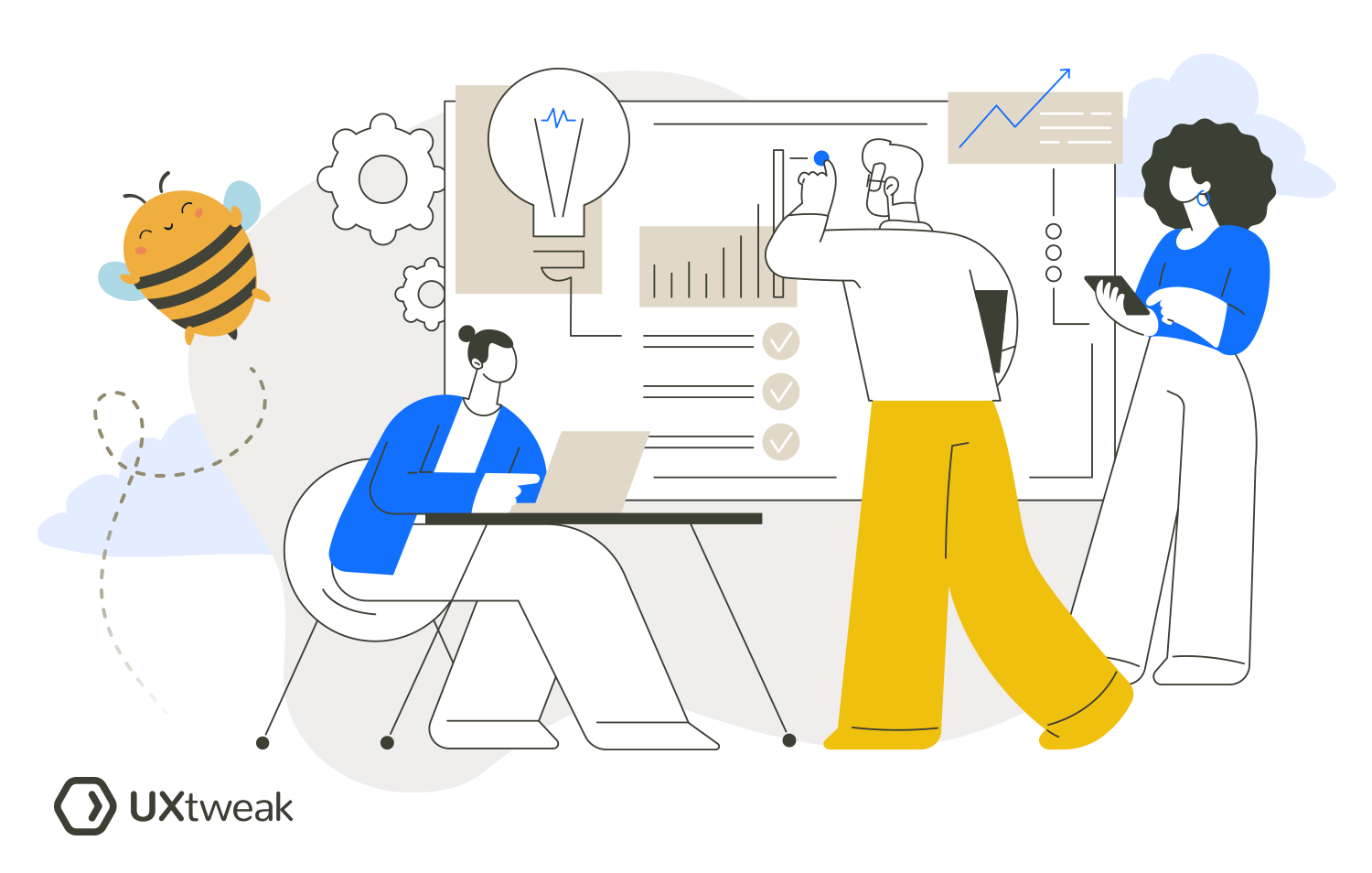From the initial spark of interest to the post-purchase communication, customers go through a whole journey with your product, interacting with it at different touchpoints. To fine-tune those interactions, make sure that they don’t face any roadblocks on the way and leave them completely satisfied, there’s a great approach called CX Research.
Let’s take a look at what CX Research entails, how it can help to improve your product and what metrics you should use to measure it’s effectiveness.
Key Takeaways:
➡️ CX Research examines customer interactions at all stages, aiming to enhance the overall experience.
❗ It’s vital for pinpointing customer roadblocks, confusion, and dissatisfaction throughout their journey.
✅ Insights from CX Research drive improvements in service, product development, and user experience.
🧠 Effective CX Research requires a blend of qualitative and quantitative methods for a complete view.
💡 Regularly conducting CX Research ensures continuous improvement and adaptation to changing customer needs.
What is CX Research?

Customer Experience Research (or CX Research) is the process of collecting insights about customers’ interactions with the company and using them to pinpoint areas of improvement. This kind of research aims to understand the process a customer goes through before, during, and after making a purchase or engaging with your product or service.
The main goal of customer experience research is to identify the roadblocks your customers encounter, points of confusion and dissatisfaction, etc. This information is later used to improve the level of customer satisfaction with your product and brand overall, increase loyalty, and build trust.
Insights from CX research are useful in all kinds of areas and can help to improve service delivery, user experience, product development, conversion rate optimization, and customer service practices.
CX Research Characteristics
Some of the key characteristics of CX research include:
- Holistic Perspective: CX research considers the entire spectrum of a customer’s interaction with a company, including the stage of awareness, pre-purchase activities, the purchasing process itself, as well as post-purchase support and engagement.
- Customer-Centricity: Just like customer experience itself, CX research is built around the needs, wants, and pain points of the customer, making them the center of any product decisions.
- Qualitative and Quantitative: Customer experience research aims to look at customer experience from different perspectives, and therefore takes into account both qualitative and quantitative insights to see the full picture.
- Continuous Process: CX research requires a continuous collection of customer insights in order to track changes and ensure constant improvement.
- Cross-Functional Involvement: Effective customer research requires collaboration across various departments within an organization, from marketing and sales to product development and customer service.
- Emotional Connection: CX research aims to study and understand the emotional responses of customers to your product, and use this knowledge to make them more positive.
- Metric-Oriented: Customer experience research is largely focused on tracking specific CX metrics to quantify the customer experience and benchmark progress. We’ll talk about these metrics and how to track them below.
Why is Customer Experience Research Important?

Customer experience research is a crucial process that helps to identify areas of improvement in your product’s CX and tackle them to increase customer satisfaction. Without customer research and customer feedback collection, you’re risking detaching from your customers and overseeing critical issues in the products or services you provide.
CX research helps you stay connected with your audience, understand what they need and expect from you, and how you can make your product and services better to fit those needs.
If we put it together, here are 4 main benefits of customer experience research:
Informed Decision Making
Implementing CX research in your strategy will ensure that you have enough information about your customers before making any decisions. You’ll know how they perceive your product, what frustrates them, and what specific improvements could make them more satisfied.
Basing your decision-making on data and not just vague assumptions is the key to building a successful product that customers love.
Competitive Advantage
By understanding the nuances of customers’ unique interactions with your product you’re able to fine-tune your CX to the point when it’s superior to your competitors.
Many companies still underestimate the power of CX research, so by tackling customers’ problems and showing your commitment to providing them with exceptional experiences, you’ll absolutely get a competitive edge.
Customer Retention
A positive customer experience is a key driver for loyalty. Happy customers are more likely to come back and are less price-sensitive. By conducting CX research, showing customers that their feedback matters, and acting on the collected insights, you are building long-lasting relationships and trust.
Reducing Churn
Customer experience research helps to identify and address issues in the customer journey and tackle them to reduce churn. It pinpoints areas where customers get frustrated and explains what keeps them from staying with you.
By tackling those issues you can stabilize your revenue stream, ensuring a high level of customer satisfaction and low churn rates.
Customer Experience Research Metrics

To gauge the health of customer-company interactions, CX research relies on a bunch of key metrics:
Net Promoter Score (NPS)
Net Promoter Score measures the likelihood of a customer recommending a company, product, or service to others (for example, their colleague or friend). This metric is collected with the help of surveys and popup forms and is based on the answer to a single question: “On a scale of 0 to 10, how likely are you to recommend our company/product/service to a friend or colleague?”.
Based on the answer, people are segmented into promoters, passives, and detractors, providing a clear indication of customer loyalty and brand enthusiasm. A high NPS (above 0, but ideally above 50) is good and suggests strong customer loyalty. A low or negative NPS indicates dissatisfaction and a higher risk of churn.
Customer Satisfaction Score (CSAT)
Customer Satisfaction Score measures short-term happiness with a product, service, or specific interaction. It’s typically gathered in post-event surveys by asking the customer to rate their satisfaction with the experience they just had often on a scale (such as 1 to 5 or 1 to 10), or through binary yes/no questions.
It is a great metric that helps to quickly identify and react to issues. A high CSAT score indicates customers are satisfied, while a low CSAT score points to potential problems in the customer experience that need addressing.
Customer Effort Score (CES)
Customer Effort Score aims to track the ease of customer interaction and problem-solving with a company. It helps to evaluate the effectiveness of the company’s support team and the effort customers need to make to solve issues with your product.
This metric is also collected through surveys, usually by sending a satisfaction form after an interaction with the support team and solving a customer’s problem. Customers are asked to rate the effort required to interact with a company on a numerical scale, often from “Very Easy” to “Very Difficult”.
Time to Resolution
Time to Resolution is a simple metric that indicates the average amount of time it takes to resolve customer issues or support requests. This metric gives a great overview of the efficiency of the customer support process.
Shorter times to resolution are generally positive, suggesting effective customer support, while longer times could indicate systemic issues in the service process or problems with your support team.
Time to resolution is usually tracked with the help of customer service software that logs the time from when a customer issue is reported until it is resolved. The metric is calculated by averaging the resolution times over a set period.
First Contact Resolution (FCR)
FCR tracks the percentage of customer inquiries or issues resolved in the first interaction. This metric again provides insight into the effectiveness of the support team, while also impacting customer satisfaction and operational costs.
Ideally, you want to have a high FCR, meaning that most of the customer problems are solved at the first contact. A low FCR can lead to customer frustration and increased support costs. Just like the Time to Resolution, this metric is tracked by customer support software, or sometimes via distributing surveys.
Churn Rate
The churn rate is the rate at which customers stop doing business with a company. This metric is directly tied to your company’s revenue. Low churn rates indicate that your retention strategies are effective and the customers are satisfied. However, high churn can signal some critical issues.
The churn rate is calculated by dividing the number of customers lost during a period by the number at the beginning of this period.
Conversion Rate
Conversion rate is the percentage of customers who take a desired action with your product. This could be making a purchase, signing up for your services, etc. It’s a great metric to track the effectiveness of your marketing strategies, as well as the level of user experience your product provides.
A high conversion rate suggests that customer touchpoints are effective in driving the desired action, without causing any confusion and usability issues on the way. A low conversion rate usually signifies issues in the sales funnel or user experience.
Conversion rates are usually tracked by your web analytics platform of choice, Google Analytics, for example.
Customer Lifetime Value (CLV)
CLV is the total revenue a company can expect from a single customer account over time. This metric helps to determine how much to invest in retaining customers and identify high-value customer segments.
CLV is calculated using historical data on purchase frequency, average order value, and customer lifespan. It may also require complex analytics to predict the future value of a customer based on past behaviors.
Ideally, your company wants to aim for a high Customer Lifetime Value, as it indicates customer loyalty and the effectiveness of your CX activities.
Average Handle Time (AHT)
Average Handle Time is the average duration of a customer transaction or interaction, including all related tasks. This metric is tracked through customer service and call center software, which records the entire duration of the interaction with customer support, including hold time, talk time, and follow-up work required after the call to solve the issue.
It’s also a great metric to measure the efficiency of your customer service team, and how it impacts customer satisfaction.
A lower AHT can indicate efficient service, however, when the AHT is too low, it might also suggest that issues are not being fully resolved. A higher AHT may mean both thorough service or inefficiency, so this metric also needs to be backed up with further research.
CX Research Best Practices
💡To have a better understanding what factors drive the success CX research, we recommend watching our video guide first and then continuing reading the article.
- Segment your audience: different customer segments usually have different experiences with your product and face different problems. Make sure you segment your audience and the data you get from CX research accordingly. This will help you better understand those differences and tailor your strategies to fit all.
- Close the customer feedback loop: Maku sure to not only collect the data but also act on it, introduce changes and improvements, and let customers know how their feedback is making your product better.
- Make it a continuous process: CX research is not just a one-time thing. In order for it to be effective and actually make a difference you need to make it an ongoing process. This way you’ll be able to keep up with customers’ ever-changing needs and keep your product in the best shape.
- Measure the impact of changes: After implementing new changes based on your CX research data, don’t forget to measure their impact. This will be helpful for guiding your future CX strategy and understanding the effectiveness of the improvements.
- Ask other teams for feedback: collaborate cross-functionally and involve other teams in the CX research process. People who interact with the customers directly, (like sales, marketing, and customer support) can help uncover a lot of unexpected insights that you won’t get anywhere else.
- Ensure data privacy: Always respect customer privacy and adhere to data protection regulations. Transparently communicate how customer data is being used, ask for consent, and ensure their data is handled securely.
Wrapping up
Mastering Customer Experience Research is like having a roadmap to your customers’ hearts and minds. With the data you collect, you’re able to understand what issues they face and how you can make your product better to eliminate those.
Collecting and measuring customer data may seem like a complex task, but not with the right tools at hand. UXtweak is an all-in-one research tool that will help you conduct holistic customer experience research to better empathize with customers, predict their behavior and discover customer pain points.



